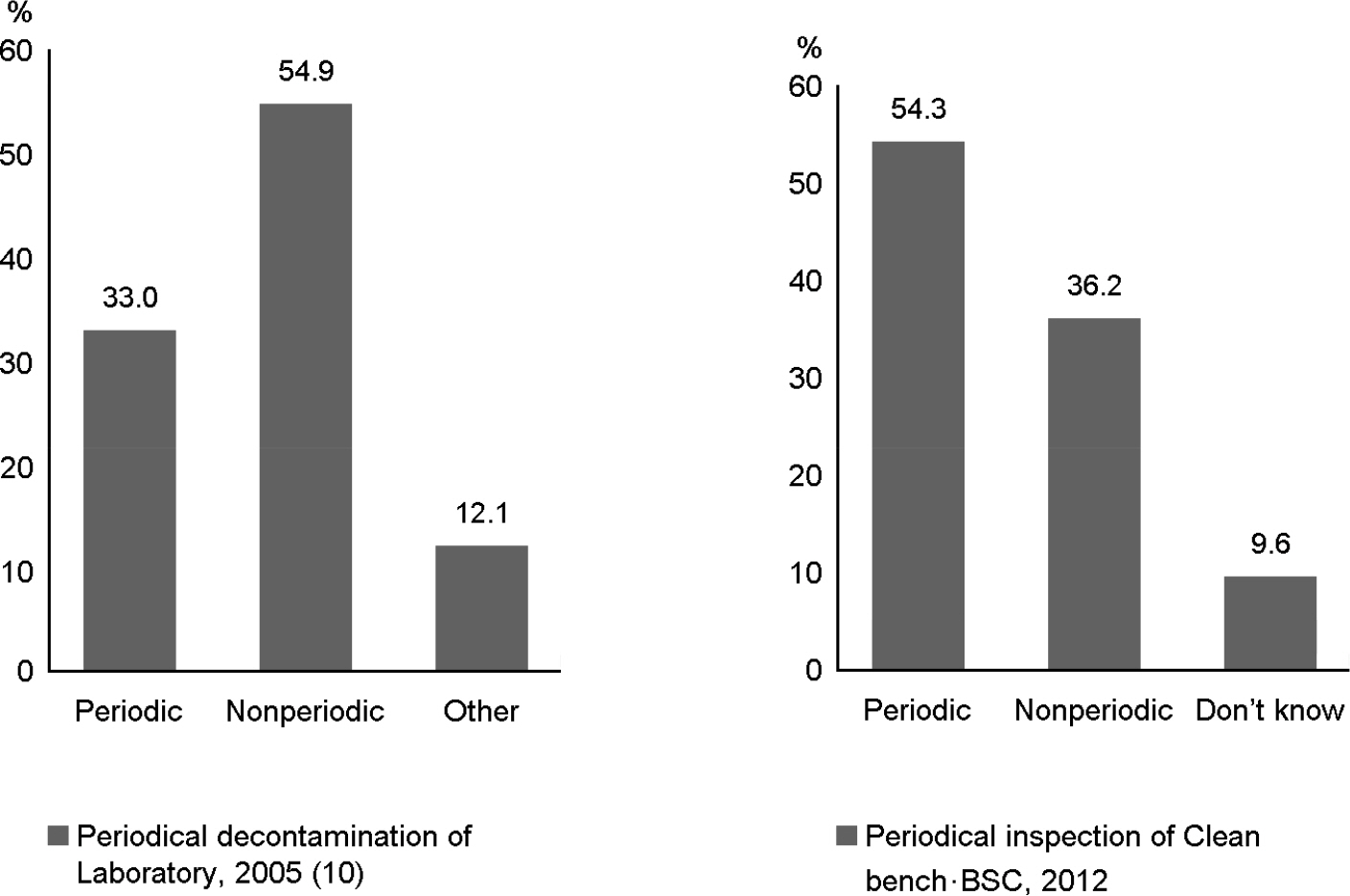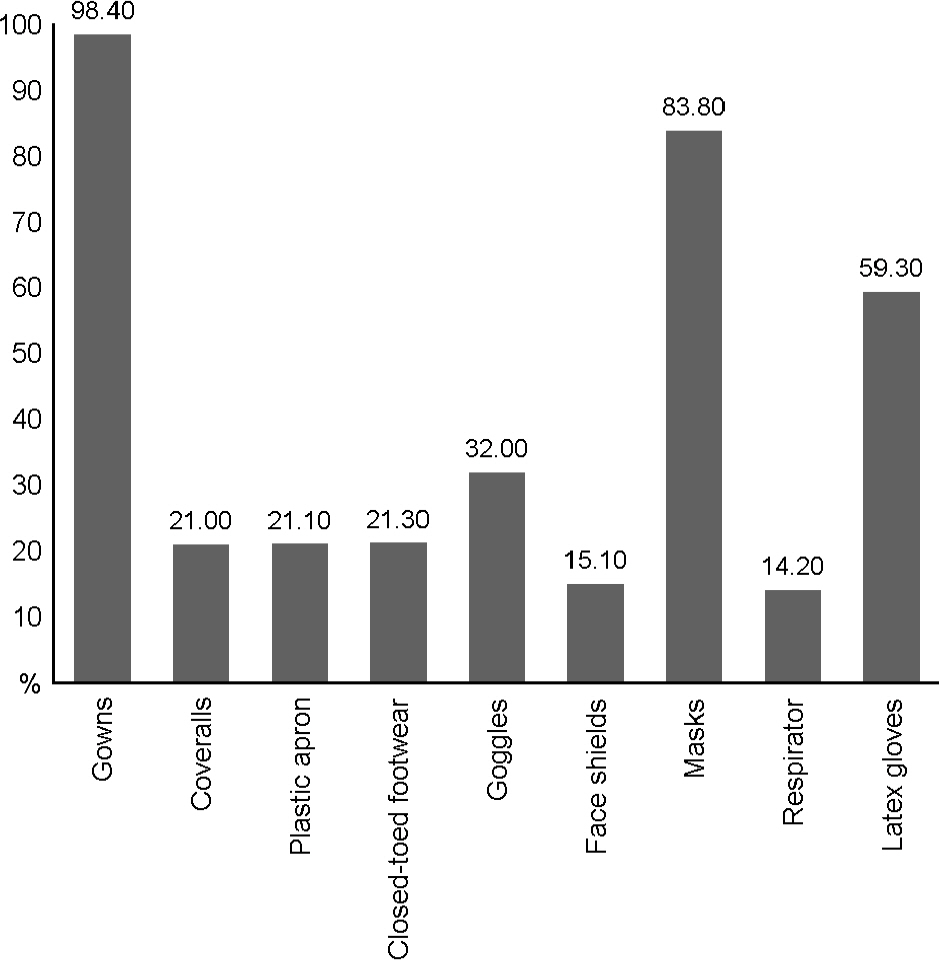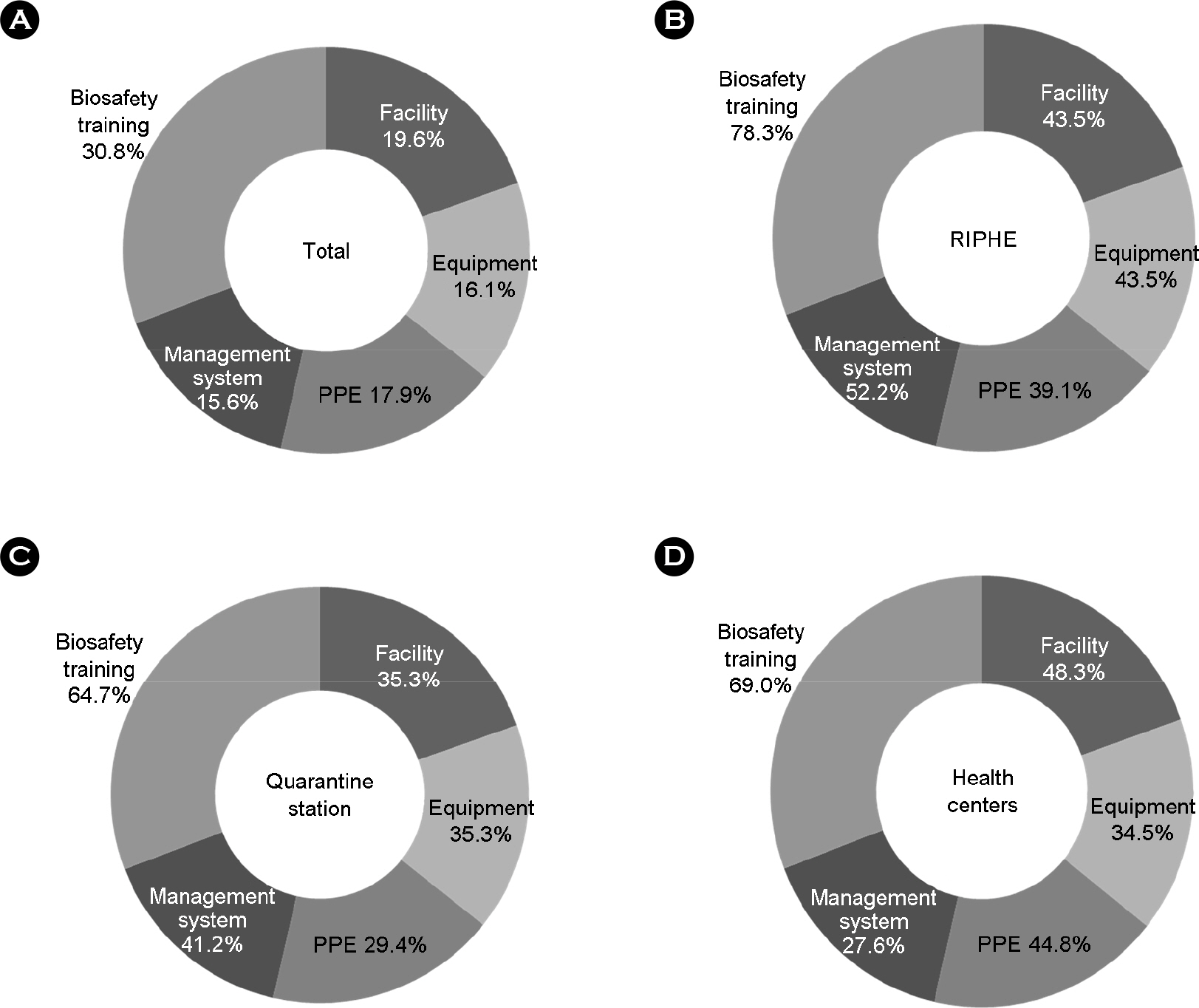J Bacteriol Virol.
2013 Sep;43(3):217-228. 10.4167/jbv.2013.43.3.217.
A Survey on Laboratory Biosafety Status of Public Healthcare Centers in Korea
- Affiliations
-
- 1Department of Microbiology, College of Medicine, Konkuk University, Seoul, Korea. wjjang@kku.ac.kr
- 2Institute of Glocal Disease Control, Konkuk University, Seoul, Korea.
- 3Internationl Vaccine Institute, Seoul, Korea.
- KMID: 2286276
- DOI: http://doi.org/10.4167/jbv.2013.43.3.217
Abstract
- The purpose of this study was to explore the laboratory biosafety status of Public Health Centers (PHCs) in Korea during Oct.7~26, 2012. We surveyed the environment of biosafety management, especially for the recognition level for biosafety of workers in the organizations. The questionnaires given out to 98 workers who are working for PHCs are to research the recognition level of workers for the knowledge of biosafety, related laws and regulations. The level was the highest in the Research Institute of the Public Health & Environment (RIPHE) followed by quarantine station, and the health center was assessed as the last. It was turned out that the biosafety educational program in the RIPHE was implemented on a regular basis (65.2%) with irregular cases (21.7%), and some outsourcing chances (8.7%). However, quarantine stations and health centers didn't practice actively biosafety training programs compared to RIPHE. In addition, there was a majority of opinions that the most important thing to improve biosafety level of PHCs is to strengthen current poor training and education system. In conclusion, it is necessary to develop more improved training system for biosafety on exposure risks including injuries, personal protective equipment, and chemical hazards.
MeSH Terms
Figure
Cited by 2 articles
-
Survey on the Status of Biosafety Awareness Among Domestic Biology Researchers
Kyung-Min Lee, Dong-Wook Kim, Yeon-Joo Choi, Kyung-Hee Park, Won-Jong Jang
J Bacteriol Virol. 2017;47(2):96-101. doi: 10.4167/jbv.2017.47.2.96.The Management of Laboratory Biological Safety in Korea
Kyung-Min Lee, Yeon-Joo Choi, Kyung-Hee Park, Won-Jong Jang
J Bacteriol Virol. 2014;44(4):342-351. doi: 10.4167/jbv.2014.44.4.342.
Reference
-
1). Shaw K. The 2003 SARS outbreak and its impact on infection control practices. Public Health. 2006; 120:8–14.
Article2). Zhao Z, Zhang F, Xu M, Huang K, Zhong W, Cai W, et al. Description and clinical treatment of an early outbreak of severe acute respiratory syndrome (SARS) in Guangzhou, PR China. J Med Microbiol. 2003; 52:715–20.
Article3). Gatherer D. The 2009 H1N1 influenza outbreak in its historical context. J Clin Virol. 2009; 45:174–8.
Article4). Tellier R. Aerosol transmission of influenza A virus: a review of new studies. J R Soc Interface. 2009; 6:783–90.
Article5). Summary of human infection with highly pathogenic avian influenza A (H5N1) virus reported to WHO, January 2003-March 2009 cluster associated cases. Wkly Epidemiol Rec. 2010; 85:13–20.6). Pinto VN. Bioterrorism: Health sector alertness. J Nat Sci Biol Med. 2013; 4:24–8.
Article7). Inglesby TV, O'Toole T, Henderson DA, Bartlett JG, Ascher MS, Eitzen E, et al. Anthrax as a biological weapon, 2002: updated recommendations for management. JAMA. 2002; 287:2236–52.8). Henderson DA, Inglesby TV, Bartlett JG, Ascher MS, Eitzen E, Jahrling PB, et al. Smallpox as a biological weapon: medical and public health management. Working Group on Civilian Biodefense. JAMA. 1999; 281:2127–37.9). Jank B, Gaugitsch H. Decision making under the Cartagena Protocol on Biosafety. Trends Biotechnol. 2001; 19:194–7.
Article10). Lee JY, Eun SJ, Park KD, Kim JK, Im JS, Hwang YS, et al. Biosafety of microbiological laboratories in Korea. J Prev Med Public Health. 2005; 38:449–56.11). Martini GA, Schmidt HA. Spermatogenic transmission of the “Marburg virus”. Klin Wochenschr. 1968; 46:398–400.12). Oliphant JW, Parker RR. Q fever: Three cases of laboratory infection. Public Health Rep. 1948; 63:1364–70.
Article13). Beeman EA. Q fever; An epidemiological note. Public Health Rep. 1950; 65:88–92.
Article14). Holmes GP, Hilliard JK, Klontz KC, Rupert AH, Schindler CM, Parrish E, et al. B virus (Herpesvirus simiae) infection in humans: epidemiologic investigation of a cluster. Ann Intern Med. 1990; 112:833–9.
Article15). Barton Behravesh C, Mody RK, Jungk J, Gaul L, Redd JT, Chen S, et al. 2008 outbreak of Salmonella Saintpaul infections associated with raw produce. N Engl J Med. 2011; 364:918–27.
Article16). Cho A, Seok SH. Ethical Guidelines for Use of Experimental Animals in Biomedical Research. J Bacteriol Virol. 2013; 43:18–26.
Article17). Barkham TM. Laboratory safety aspects of SARS at Biosafety Level 2. Ann Acad Med Singapore. 2004; 33:252–6.18). Lim W, Ng KC, Tsang DN. Laboratory containment of SARS virus. Ann Acad Med Singapore. 2006; 35:354–60.19). MacNeil A, Reynolds MG, Damon IK. Risks associated with vaccinia virus in the laboratory. Virology. 2009; 385:1–4.
Article20). Chong PY, Chui P, Ling AE, Franks TJ, Tai DY, Leo YS, et al. Analysis of deaths during the severe acute respiratory syndrome (SARS) epidemic in Singapore: challenges in determining a SARS diagnosis. Arch Pathol Lab Med. 2004; 128:195–204.
Article21). Koh D, Sng J. Lessons from the past: perspectives on severe acute respiratory syndrome. Asia Pac J Public Health. 2010; 22:132S–6S.
Article22). Orellana C. Laboratory-acquired SARS raises worries on biosafety. Lancet Infect Dis. 2004; 4:64.
Article23). Jiang TJ, Zhou XZ, Zhao M, Zhou ZP, Jiang SC, Ye WH, et al. Analysis of severe acute respiratory syndrome in Beijing. Zhonghua Nei Ke Za Zhi. 2003; 42:369–72.24). Lee HW, Johnson KM. Laboratory-acquired infections with hantaan virus, the etiologic agent of Korean hemorrhagic fever. J Infec Dis. 1982; 146:645–51.
Article25). Kim JS, Lee HW. Studies on microbiololgical laboratory biosafety a survey on biosafety status in laboratory department of training. Report NIH Korea. 1986; 23:139–60.26). Cho SH, Ju YS, Kang D, KiM S, Kim IS, Hong ST. Laboratory-acquired infection with hantavirus at a research unit of medical school in Seoul, 1996. Korean J Prev Med. 1999; 32:269–75.27). U.S. Department of Health & Human Services, Center for Disease Control and Prevention, National Institutes of Health. Biosafety in Microbiological and Biomedical Laboratories (BMBL). 5th ed.Washington D.C.: CDC/NIH;2009. Available from: URL:. http://www.cdc.gov/biosafety/publications/bmbl5/BMBL.pdf.28). World Health Organization. Laboratory biosafety manual. 3rd ed.Geneva: World Health Organization;2004. Available from: URL:. http://www.who.int/csr/resources/publications/biosafety/Biosafety7.pdf.29). Hui Z, Jian-Shi H, Xiong H, Peng L, Da-Long Q. An analysis of the current status of hospital emergency preparedness for infectious disease outbreaks in Beijing, China. Am J Infect Control. 2007; 35:62–7.30). Salman MD. Controlling emerging diseases in the 21st century. Prev Vet Med. 2004; 62:177–84.
Article31). Lau JT, Yang X, Leung PC, Chan L, Wong E, Fong C, et al. SARS in three categories of hospital workers, Hong Kong. Emerg Infect Dis. 2004; 10:1399–404.
Article
- Full Text Links
- Actions
-
Cited
- CITED
-
- Close
- Share
- Similar articles
-
- Survey on the Status of Biosafety Awareness Among Domestic Biology Researchers
- Biosafety of Microbiological Laboratories in Korea
- Viral Infections in Workers in Hospital and Research Laboratory Settings
- National Survey on Biosafety in Clinical Tuberculosis Laboratories in Korea
- Biosafety Risk Control Strategies in Laboratory Animal Research





